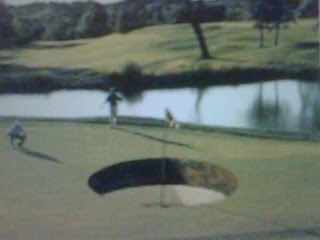Reading Greens

When you read a book, it allows you to imagine, visualize, put a picture in your head, hazard a guess. Some say that reading a book is better than watching a movie. You read till the drama unfolds. There are golfers who could hit a bazooka of a shot for 250m from the tee but then in the next 100m, you need another 3 shots to get onto the green.
Worse, you three putted. That's a triple bogey on a par 4. You may have to work on your short game from 100m in and probably also your putting. Other than this, you can make an immediate improvement to your game by reading the greens with appropriate measures. Armed yourself with useful information and prepare for better results. Here's how:
Worse, you three putted. That's a triple bogey on a par 4. You may have to work on your short game from 100m in and probably also your putting. Other than this, you can make an immediate improvement to your game by reading the greens with appropriate measures. Armed yourself with useful information and prepare for better results. Here's how:
Line of Putt
You just don't putt to the hole simply because there are undulating and uneven lies with breaks to the left or to the right. Uphill, downhill and those across a slope. You have to putt onto the line that takes your ball to the hole or close and then there are other factors involved.
Control and Speed
Essentially, control and speed are critical ingredients and of significant importance. There is less chance of a ball breaking when it is rolling quicker. Conversely, a ball breaks very quickly when rolling at a slower pace. The maximum pace of your putt should be one that brings the ball up to one or one and a half foot past the hole. Pace is dependent on length of the grass and moisture present. This required the right speed that will help to ensure that the ball can hold its line of putt. Speed is crucial on hard, fast greens as they may not break as much as it actually appears even if you roll them softly. If you putt it short, you are never going to get a chance to hole it, that is why you have to putt over the hole and if you don't hole it you are at least giving yourself a chance. Besides, putting short does not allow you to read the forward line for your next putt whereas putting over gives you a glimpse how the return trip should look like. Other factors like, slope, green speed, moisture, base (hard or soft), grain of the green plays a part too. It is also necessary to squat down where you'll be closer to the ground to see the line and the breaks before you even align your putt.
Target a Point
When you step onto the green, study the contours and make assessments of whether it is uphill, downhill or across slopes. Think of how the pace of a putt should be and envisage to pick a point as your target path or know where it will break and hit the ball at the right speed to take that line or break. Find a reference point in front of you, it can be two feet, six feet or ten feet away in front but this one point between the ball and the target is your line of putt that will take you to paradise. Some golfers may even take up to two points of reference but it may be unnecessary. Imagine pouring water on the green so that you could now see between the ball position and the hole where and how the water will flow. That would be the path.
Down Slope Putt
Your initial stroke of the ball will get the ball rolling straight at first but as the ball rolls nearer to the hole, it will lose its momentum and slow down as it looses speed. At this point, gravity takes over. The down slope putt is always more difficult than the up slope putt. It is useful to note that you can obtain information by watching approach chips and putts of your own or of other players playing before you to understand the the green. Always look from the lower side of the hole. On a down slope putt, you will need less momentum as gravity will pull the ball and the ball will take the direction of the true slope. Allow for more breaks. Remember - "less speed is more break".
Uphill Putt
It is a lot easier uphill due to less breaks. It is a case of more speed and a firmer putt so that you will get less break. Always remember that the ball takes any break when it loses speed or "die" and gravity takes over to follow the slope.
Side Slope (Across)
Side slopes are as treacherous. They are first uphill and then downhill spanning across the green. You will have to determine an area around the hole where the ball is likely to "die" as it would greatly influence the result of the putt.
Greens
Greens are not jsut vegetables. 90% of greens are built low in front and high at the back for practical reasons. One is for drainage and the other is the angle needed to allow taking an approach shot giving your ball a chance to stop on the green. When the pros are playing and as they walk onto the green, they are feeling all the time like using all their feelers like an insect probing around to sense the steepness and gradient of the slope with their feet.
On Bermuda grass, the ball might break even going uphill if the grain is strong enough. Bermuda grass grows towards the setting sun or water bodies and always towards the draining areas. So, the next time you step onto that first green, the first question is where does the sun set? Other golfers may think that you are mad or about to walk into the sunset but this gives you an indication how the ball will break. Look out for shiny parts of the green. No, you are not looking for some dropped shillings.
The grain grows away from the shiny parts. If you look at the dull parts, you are looking into the grain. The putt is then slow when the grain is growing into you (against) and when the grain is growing away from you (forward flow) the putt becomes faster. Ditto for putts breaking to the left if the grain grows left and vice versa for the right. Direction of shiny part = "fast". Direction of dull part (against grain) = "slow". If you feel like walking on cushion then the green is moist and slow.
Grain
Grain is the direction in which grass grows. You will never dream of the day that will come to make you watch how grass grows but I assure you it is better than watching paint dry. Grass that grows straight up doesn't affect your putt. Grain grows away from mountains and hills and towards oceans, seas and lakes. In an uphill putt in the direction and flow of the grain it is equal to putting on a flat surface. The uphill slows you down but the direction of the flow of the grain neutralise that. When the line of putt goes against the grain, the break is as good as cancelled. The grain is like a piece of wood and it indicates the direction of the growth.
In a Nutshell
Ask the following questions: Is it uphill, downhill or flat? Is it fast, slow or normal? Does it break left, right or is straight? If you are not an avid reader or if you don't read it from the first page, you may soon realise that it is a mystery novel unravelling with nasty surprises awaiting you at the end. Greens are built to remove water on it. See where the water will run off from the green.
They always break towards the water! During the monsoon season of November and December, you will have plenty of hands on experience to observe all these. Remembering these and observing them will help you save plenty of strokes and money. Very often, when someone putts under or over by a mile, it is usually not because they were unable to judge the distance and then failed to co-ordinate it but it is usually a case of failure to read the green. After the putt, you could hear them saying: "I didn't know it was downhill!"
Maybe they should simplify golf and put "Green Traffic Wardens" in place to stick warning signs for each golfer like "Beware! Steep slope ahead!" "Down slope, slippery when wet!" I only saw signs that stated: "Beware of Snakes" or "Crocodile spotted here". No one can give you true advice once you are on the green because nobody knows how hard you will hit the ball. Only you can determined your own line. Do your own thing. Life is stressful and so is golf. Remember, I'm helping you to relief pain, ease your discomfort, destress and give you hope.
Don't just eat your greens, read them too or you will weep. For whom the bells toll.
Golf as in life, play as it lies!
Maybe they should simplify golf and put "Green Traffic Wardens" in place to stick warning signs for each golfer like "Beware! Steep slope ahead!" "Down slope, slippery when wet!" I only saw signs that stated: "Beware of Snakes" or "Crocodile spotted here". No one can give you true advice once you are on the green because nobody knows how hard you will hit the ball. Only you can determined your own line. Do your own thing. Life is stressful and so is golf. Remember, I'm helping you to relief pain, ease your discomfort, destress and give you hope.
Don't just eat your greens, read them too or you will weep. For whom the bells toll.
Golf as in life, play as it lies!



Comments